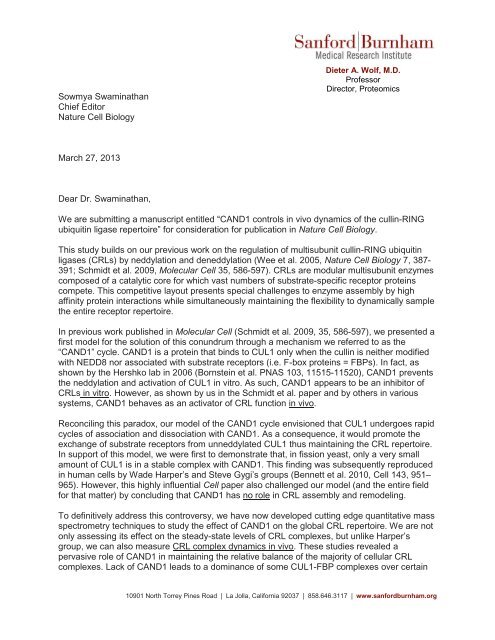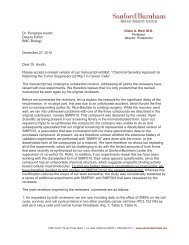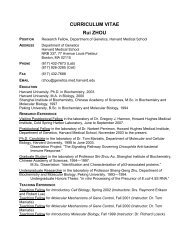Cover letter - Sanford-Burnham Medical Research Institute
Cover letter - Sanford-Burnham Medical Research Institute
Cover letter - Sanford-Burnham Medical Research Institute
Create successful ePaper yourself
Turn your PDF publications into a flip-book with our unique Google optimized e-Paper software.
Sowmya Swaminathan<br />
Chief Editor<br />
Nature Cell Biology<br />
Dieter A. Wolf, M.D.<br />
Professor<br />
Director, Proteomics<br />
March 27, 2013<br />
Dear Dr. Swaminathan,<br />
We are submitting a manuscript entitled “CAND1 controls in vivo dynamics of the cullin-RING<br />
ubiquitin ligase repertoire” for consideration for publication in Nature Cell Biology.<br />
This study builds on our previous work on the regulation of multisubunit cullin-RING ubiquitin<br />
ligases (CRLs) by neddylation and deneddylation (Wee et al. 2005, Nature Cell Biology 7, 387-<br />
391; Schmidt et al. 2009, Molecular Cell 35, 586-597). CRLs are modular multisubunit enzymes<br />
composed of a catalytic core for which vast numbers of substrate-specific receptor proteins<br />
compete. This competitive layout presents special challenges to enzyme assembly by high<br />
affinity protein interactions while simultaneously maintaining the flexibility to dynamically sample<br />
the entire receptor repertoire.<br />
In previous work published in Molecular Cell (Schmidt et al. 2009, 35, 586-597), we presented a<br />
first model for the solution of this conundrum through a mechanism we referred to as the<br />
“CAND1” cycle. CAND1 is a protein that binds to CUL1 only when the cullin is neither modified<br />
with NEDD8 nor associated with substrate receptors (i.e. F-box proteins = FBPs). In fact, as<br />
shown by the Hershko lab in 2006 (Bornstein et al. PNAS 103, 11515-11520), CAND1 prevents<br />
the neddylation and activation of CUL1 in vitro. As such, CAND1 appears to be an inhibitor of<br />
CRLs in vitro. However, as shown by us in the Schmidt et al. paper and by others in various<br />
systems, CAND1 behaves as an activator of CRL function in vivo.<br />
Reconciling this paradox, our model of the CAND1 cycle envisioned that CUL1 undergoes rapid<br />
cycles of association and dissociation with CAND1. As a consequence, it would promote the<br />
exchange of substrate receptors from unneddylated CUL1 thus maintaining the CRL repertoire.<br />
In support of this model, we were first to demonstrate that, in fission yeast, only a very small<br />
amount of CUL1 is in a stable complex with CAND1. This finding was subsequently reproduced<br />
in human cells by Wade Harper’s and Steve Gygi’s groups (Bennett et al. 2010, Cell 143, 951–<br />
965). However, this highly influential Cell paper also challenged our model (and the entire field<br />
for that matter) by concluding that CAND1 has no role in CRL assembly and remodeling.<br />
To definitively address this controversy, we have now developed cutting edge quantitative mass<br />
spectrometry techniques to study the effect of CAND1 on the global CRL repertoire. We are not<br />
only assessing its effect on the steady-state levels of CRL complexes, but unlike Harper’s<br />
group, we can also measure CRL complex dynamics in vivo. These studies revealed a<br />
pervasive role of CAND1 in maintaining the relative balance of the majority of cellular CRL<br />
complexes. Lack of CAND1 leads to a dominance of some CUL1-FBP complexes over certain<br />
10901 North Torrey Pines Road | La Jolla, California 92037 | 858.646.3117 | www.sanfordburnham.org
others, suggesting an impairment of FBPs in competing for CUL1 cores. This defect was<br />
pinpointed to a requirement for CAND1 in the incorporation of newly synthesized FBPs into<br />
preexisting CUL1 complexes. We further show that lack of CAND1 greatly impairs the efficiency<br />
with which an ectopically expressed FBP can displace another FBP from a pre-existing CRL1<br />
complex. Finally, purified CAND1 can displace substrate recpetors form CUL1 in vitro, an<br />
activity we show to be required for substrate degradation. These results clearly demonstrate<br />
that, contrary to the current believe in the field, CAND1 does play a major role in regulating the<br />
dynamics of CRL complexes. Our data now prove our previous proposition of a “CAND1” cycle<br />
and further suggest that this cycle functions to globally organize the CRL repertoire.<br />
Not only do these findings solve long-standing confusions in the cullin field but they have<br />
important ramifications beyond. For one, they enable the first coherent model of CRL assembly<br />
and disassembly through biochemical coupling of CAND1 with the neddylation/deneddylation<br />
cycle. At the same time, CAND1 appears to be the founding member of a potentially larger class<br />
of protein exchange catalysts that regulate the assembly and disassembly of multi-protein<br />
complexes with a similar degree of dynamicity as CRLs.<br />
Due to their extreme plasticity, CRL enzymes permeate every aspect of biology in health and<br />
disease. Not only are individual CRL family members frequently malfunctioning in cancer, but<br />
defects at superior levels of control, such as studied in this work, can disrupt entire branches of<br />
the CRL system for better or worse. On one hand, the resulting imbalances can give rise to<br />
diseases; on the other hand, the underlying regulators are already being exploited as drug<br />
targets in blood cancer. The mechanistic insights obtained in this work may contribute to the<br />
development of even better anti-cancer drugs targeting the CRL system.<br />
As reviewers we could suggest experts in the cullin and neddylation field which include in<br />
alphabetical order: Gerhard Braus (University of Goettingen), Michele Pagano (NYU), Brenda<br />
Schulman (St. Jude), Takashi Toda (London <strong>Research</strong> <strong>Institute</strong>), and Rick Vierstra (University<br />
of Wisconsin-Madison), Ning Zheng (University of Wahsington).<br />
For reasons of potential conflict, we ask that this manuscript not be reviewed by Wade Harper,<br />
Steve Gygi or Matthias Peter.<br />
Whereas our paper can stand entirely on its own, we are co-submitting it with a related paper<br />
from Thimo Kurz’s lab that comes to the same conclusions using different approaches in<br />
budding yeast. It may also be of interest to you that we are aware of similar work from Ray<br />
Deshaies’ lab that is under consideration at Cell.<br />
Sincerely,















